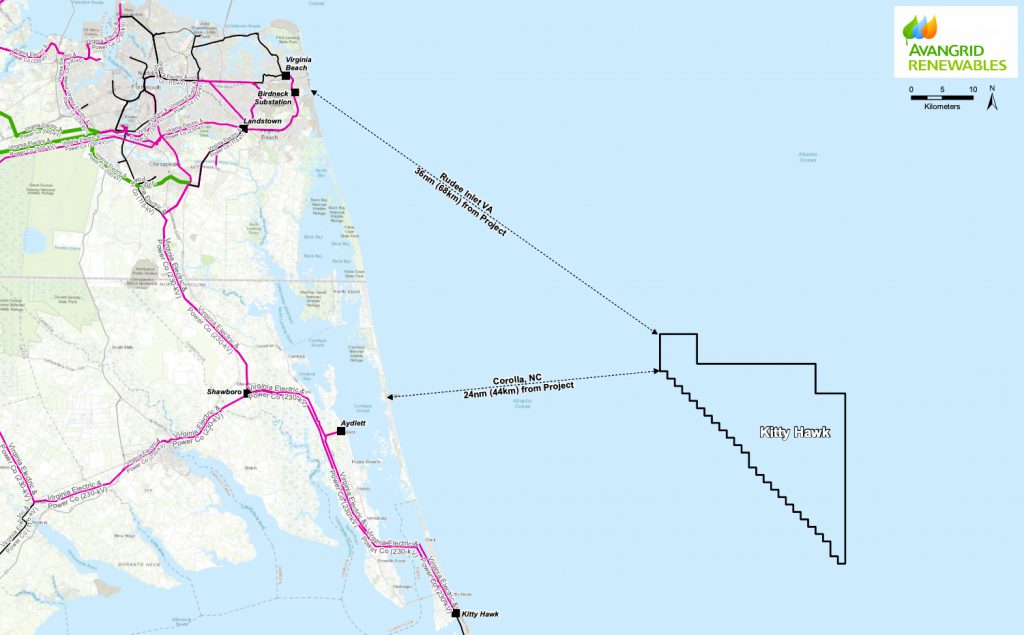
There is energy production in the Outer Banks future. Clean energy, actually. Not oil, but a known resource just waiting to be exploited.
It's wind energy. Twenty-seven miles off the coast of the northern Outer Banks there is an area called the Kitty Hawk Wind Energy Area (WEA).
Looking at it on a map, it doesn't look all that large. Look at the statistics and its massive—122,405 acre (191 sq. miles). It is not its size that is drawing attention, however. It is the potential that it holds. The numbers are still theoretical, but there should be enough wind energy in the WEA to power between 500,000 and 700,000 homes.
No other WEA on the East Coast can match that. In fact, if fully developed it would be one of the largest in the world.
The journey from being identified as a WEA to energy production is a long and complicated journey though, and the first steps in what will be a multi-year process have just happened.
Because the Kitty Hawk WEA is outside the waters North Carolina controls, the Bureau of Ocean Energy Management (BOEM) controls how it will be developed and who will develop it.
To their credit, BOEM worked closely with North Carolina in determining where the WEA was placed. As an example, one reason the eastern boundary of the site is 27 miles from shore is because of concerns about how people would react seeing turbines spinning in the wind during their stay on the Outer Banks.
After establishing the WEA, BOEM puts the site out for a lease bid. That was in 2016 and there was a lot of interest from some of the biggest names in wind energy.
The winning bid went to Avangrid Renewables for a little bit more than $9 million in March of 2019.
Avangrid has not yet begun developing the area, although they are doing extensive survey work to determine the best placement for turbines and the specific areas of strongest and most consistent winds.
A subsidiary of a large Spanish energy firm, Avangrid already has a footprint in northeastern North Carolina. In partnership with Amazon, they developed a 208 MW wind farm in Perquimans and Pasquotank counties outside of Elizabeth City.
Will there be energy generated from the Kitty Hawk WEA? At some point probably; the potential is simply too great to not develop.
But under the best of circumstances, if everything comest together perfectly, it will be five, and more likely six years before the first kilowatt of power flows from the Atlantic Ocean to the shore.
When the first Environmental Assessment of the Kitty Hawk WEA was announced in 2012, there were no offshore wind farms in US waters. In 2016 the first, and still only, offshore wind farm off Block Island, Rhode Island began generating energy. A little less than five miles offshore, the site consists of five turbines generating 6MW of energy, enough to power Block Island which had been dependent on diesel generators.
Avangrid does not yet have a buyer for the energy Kitty Hawk would produce, but a number of factors make the project very attractive.
The price of wind energy had dropped significantly since Block Island came on line. Block Island is producing energy at $.25/kwh. The national average is a little over $.13/kwh making that project very expensive. But the cost of producing offshore wind energy has plummeted, and is now under $.10/kwh, significantly less than the national average.
Bringing the Cost Down

There are a number of reasons for that. The cost of construction has fallen as more is learned about how to build the platforms for the turbines. There has been remarkable improvements in the durability of the turbines, lowering maintenance and replacement costs.
The biggest improvement, though, has been in blade design. Four or five years ago, turbine blades were 250' and capable of generating 7MW. The latest generation are 350' and are capable of generating 12MW of energy. They will also operate in lower winds.
For the Kitty Hawk WEA to come on line there are still a number of significant hurdles to leap. There are going to be environmental hearings on the siting of the platforms. Bringing the energy to shore may be the biggest engineering problem to address. The nearest location that could handle the amount of expected energy is in Virginia Beach,70 miles from the WEA.
It does seem as though the stars are aligning, although it may be another five, six or maybe even seven years. But wind energy from the Outer Banks seems likely.
Dreaming of ocean breezes and soft sand? Turn that dream into reality with Joe Lamb Jr. & Associates.







